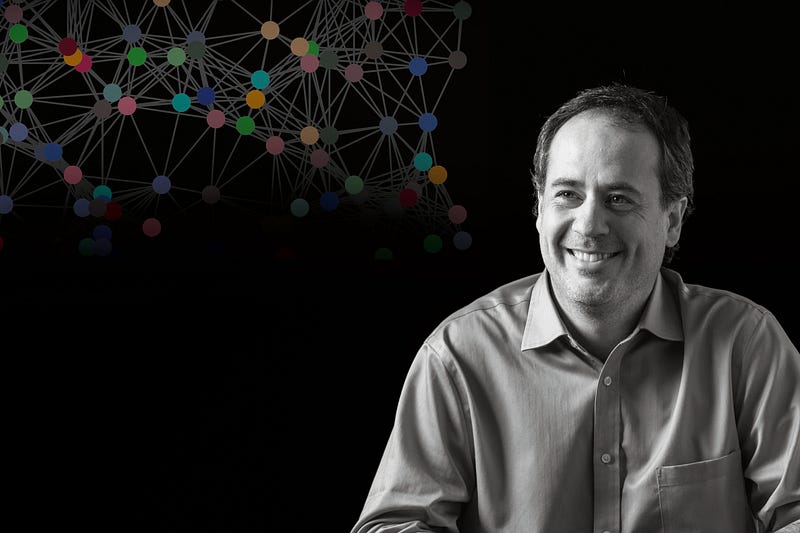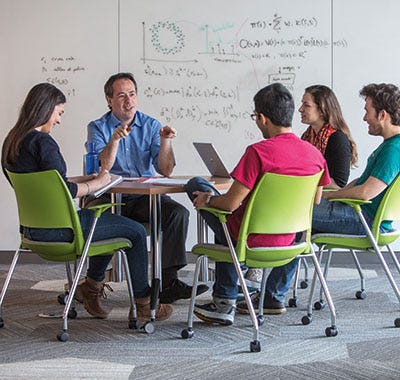
The real power behind a network, says Alejandro Ribeiro, isn’t its component parts. It’s the myriad ways they connect with one another. The social bonds we share with others. The flow of information that makes the internet possible. Even the tiny electrical impulses that appear between neurons in the brain, letting us think, feel, taste, touch and interact with the rest of world.
As an associate professor in the Department of Electrical and Systems Engineering, Ribeiro uses complex mathematical frameworks to understand how networks behave. Instead of looking at individual points in that network, he examines what’s going on between those points. “It’s really about the connections each point shares with others. If a single data point is a city on a map, we’re looking at the highways that run between each of those cities,” says Ribeiro.
SHAKESPEARE’S WORK?
The plays of William Shakespeare are just one area where Ribeiro’s work is proving useful. Although 500-year-old literature may seem an unlikely place for mathematical analysis, the field could help settle one of the thorniest mysteries surrounding the works — whether or not Shakespeare actually wrote all of them.
The Bard’s Henry IV plays have been particularly suspect, but until now, there hasn’t been a rock-solid way to confirm their authorship. Ribeiro’s work is changing that. The process involves an emerging technique called “Graph Signal Processing,” or GSP, which he has pioneered over the past several years. Along with colleagues at MIT and De Montfort University in the U.K., he created what he calls a “word adjacency network” for each of the plays, taking stock of words that appear in all of them. Rather than focusing on descriptive words that determine a play’s content, however, he used GSP to analyze the relationship between words like “the,” “and,” “a” and “to,” scrutinizing the connective tissue of each work.
“It’s not just about the number of times each word appeared, it’s about the order. Sometimes there’s a difference in those relationships,” he says. In some plays, for example, the word “they” appears more often in a sentence sometime after the word “a” is written; in others, it might come after the word “the” appears. By looking at those relationships, Ribeiro says, it’s possible to create a fingerprint for an author’s style, and by extension, their identity.
Through his analysis, Ribeiro was able to show that most of The Bard’s works corresponded with his usual style, but a few outliers didn’t. Parts of Henry VI, for instance, were strongly associated with word patterns used by Christopher Marlowe, one of Shakespeare’s contemporaries, meaning that the play could have been a collaboration.
ROBOTIC SWARMS
The complex relationships Ribeiro is teasing out of Shakespeare’s plays might also be applicable to a completely different field: swarm robotics. In the future, groups of tiny robots may be able to communicate and work with one another, like a colony of ants, to meet a shared objective such as delivering packages or inspecting a bridge.

There’s just one problem: All of those drones need to “talk” to one another to cooperate, and existing cell phone networks aren’t reliable enough to handle that traffic. Instead, the drones will need to create an ad-hoc wireless network between them, letting each robot relay messages through its peers in a giant game of telephone.
That can make collective decision-making a challenge. In a network like this, connections between individual robots would constantly change. Ribeiro is working on ways to let the drones analyze their network and determine on their own what a good wireless connection looks like.
“Two drones near each other with a strong signal would have a way to say, ‘This is a good link,’ and go from there. You want the ability to connect to other robots to be something that can be learned autonomously by the entire network,” he says. Thanks to a grant from Intel, Ribeiro has an autonomous swarm network up and running with 10 drones, and hopes to expand that number in the future.
HIGHWAYS IN THE BRAIN
In addition to large robotic swarms, Ribeiro wants to turn his attention to an even more complex network: the billions of connections between neurons in the human brain. He’s collaborating with Danielle Basset, Eduardo D. Glandt Faculty Fellow and Associate Professor in Bioengineering, to analyze and describe that web of cells mathematically using the GSP technique.
Bassett and Ribeiro’s study looked at “cognitive flexibility,” or the speed at which people can shift their focus between tasks. Over the past century, Bassett says, neuroscientists have discovered major “highways” of connected cells that carry huge amounts of neuronal activity around the brain. But in some people, that activity flows more efficiently than in others.
Using an MRI machine, the two researchers were able to see brain activity in the study’s participants as they worked through a series of visual tests. Brain signals in subjects who switched tasks easily tended to stick to well-traveled cellular highways, making a beeline for their targets; in participants with “inflexible” brains, the pair found that many of those impulses went “off road,” taking a circuitous path.
“Right now, we do not have good theory for how and why some people have more cognitive flexibility than others. These GSP tools provide new insights that might help us to develop such a theory,” Bassett notes.
MENTORING INNOVATORS
Ribeiro is adamant that he wouldn’t be applying his skills to such varied fields if it weren’t for his students. “Ph.D. candidates are the most valuable asset that a university has. I couldn’t do all that work on my own,” he says.
That sentiment also extends to undergraduates. In Ribeiro’s view, even a neophyte has the potential to tackle real-world problems, and to make a lasting contribution to their field — if they put in the work.
“I am not going to hold your hand, ever. We’re going to walk to the top of a cliff together, and I’m going to toss you down. You won’t die, but you’ll suffer, and I’ll throw you a rope to climb back up if you need it,” he says, laughing. “You can be sure not all students like that approach, but most do.”
It’s a philosophy that seems to have paid off. In 2012, Ribeiro won the S. Reid Warren, Jr., Award, which is presented annually by Penn Engineering undergraduate students in recognition of outstanding mentorship. In 2017, he won the University of Pennsylvania’s highest teaching award, the Lindback Award for Distinguished Teaching. “I’m not doing this because I find it entertaining. I’m doing this because if you allow me to push you, I can show you things that are like magic,” he says.
“I’m going to help you climb a very steep mountain of information. And even if you don’t make it to the top, that’s okay. You’ve still learned more than if you’re just climbing in the foothills.”







